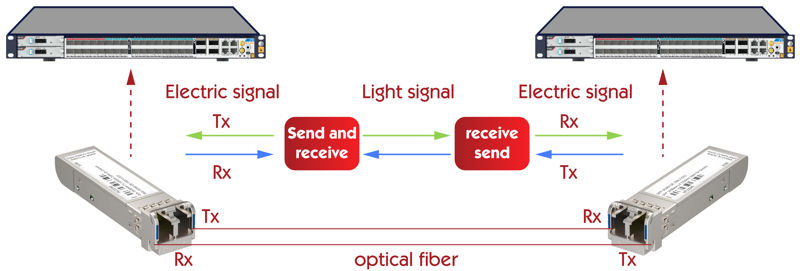Cable & Wire | High quality and excellent service at reasonable prices.
info@zion-communication.com
Author: James Publish Time: 08-08-2025 Origin: Site
In the world of optical transceivers, which underlies the evolution of modern data communication, they play a crucial role. With their vital function as a "bridge" between network devices, including switches and routers, being their primary promise, they are hot-swappable and compact modules that can be called upon. They are tasked with converting signals between electrical and optical forms and vice versa. Apart from interface types, size, and even purpose-enabling factors, optical modulator systems come in various configurations. Delving into this topic is the key to finding the most appropriate transceiver for the intended use.

An optical module, or optical transceiver, is considered the "heart" of a fiber-optic communication system. Its primary function is to convert electrical signals into optical signals for long-distance transmission and then convert received optical signals back into electrical form for data processing.
Internally, an optical transceiver consists of:
Optical transmitter (e.g., VCSEL, DFB lasers)
Optical receiver (e.g., PIN, APD photodetectors)
Electronic circuitry, including laser drivers and TIAs (trans-impedance amplifiers)
Optical interfaces (e.g., LC, SC, MPO/MTP)
Transmitting End (TX: Electrical → Optical)
The process begins with the driver chip, which picks up electrical signals from the device. Afterward, it modulates the signals and converts them to light of a specific wavelength, which is then transmitted through an optical fiber.
Receiving End (RX: Optical → Electrical)
Impulse optic varieties are typically detected by a photodetector (PIN/APD). These pulses are ultimately combined with those coming from the TIA and made into electrical signals for the receiving system.

Data rate: As a consequence, it establishes what is called transmission capacity.
Wavelength: A determinant of the signal range and the service rendered.
Transmission distance: Particularly relates to coverage.
Modulation and laser/detector types influence signal quality and stability.
Taking SFP/SFP+ (small form-factor pluggable) modules as an instance, even though there are a variety of sizes and types, they usually have this fundamental structure.

Component | Description |
Dust Cap | Protects the optical interface from contaminants and damage |
Pull Tab / Bail Latch | Facilitates insertion/removal; color-coded for quick identification |
EMI Spring | Ensures firm electrical contact and shielding in SFP cages |
Label | Displays key specs and manufacturer details |
Housing | Protects internal components and provides shielding |
RX Port | Receives incoming optical signals |
TX Port | Transmits converted optical signals |
SFP Connector Interface | Links to host device for signal and power delivery |
optical transceivers are divided into corresponding categories,Proper selection depends on specific application requirements.
Major Classification Dimensions
Category | Options |
Form Factor | SFP, SFP+, SFP28, XFP, QSFP+, QSFP28, QSFP56, QSFP-DD, OSFP, CFP, CFP2, CFP4 |
Data Rate | 10Mbps, 100Mbps, 1.25Gbps, 10Gbps, 25Gbps, 40Gbps, 100Gbps, 200Gbps, 400Gbps, 800Gbps |
Wavelength | 850nm, 1310nm, 1490nm, 1550nm, CWDM, DWDM |
Fiber Mode | Single-mode (SMF), Multi-mode (MMF) |
Transmission Distance | 100m, 300m, 550m, 2km, 10km, 40km, 80km, 120km, 160km |
Modulation Format | NRZ, PAM4, DP-QPSK, n-QAM |
WDM Support | Gray optics (non-WDM), Colored optics (CWDM/DWDM supported) |
Connector Type | LC, SC, MPO/MTP |
Duplex Mode | Duplex (Dual-fiber Bi-directional), BiDi (Single-fiber Bi-directional) |
Laser Type | VCSEL, FP, DFB, EML, DML |
Detector Type | PIN photodiode, APD (Avalanche Photodiode) |
Hot-swappable | Yes – supports live swapping |
Operating Temperature | Commercial (070°C), Extended (-2085°C), Industrial (-40~85°C) |
Of these, form factor, data rate, and transmission distance are the most significant. Transceiver models commonly used in switches for today's networks are available in QSFP-DD, QSFP28, SFP28, and SFP+ formats.
Optical modules are the fundamental components of modern fiber-optic communication technology, enabling high-speed, high-reliability data transmission over long distances. A digital world with ever-increasing speed—this demand for cloud computing, data centers, 5G, or AI—gives validity to the transceiver structure and classification as a key factor in the effective building of network infrastructures.

James is a technical manager and associate at Zion Communication.
Specializes in Optical Fiber communications, FTTH Solutions,
Fiber optic cables, ADSS cable, and ODN networks.
james@zion-communication.com
+86 13777460328
